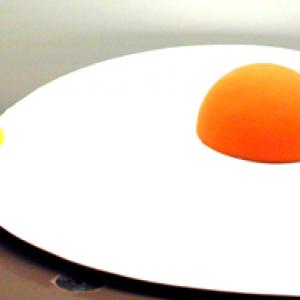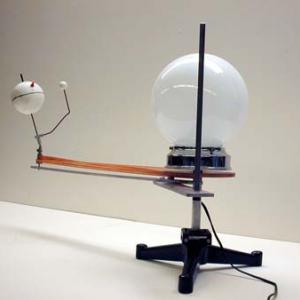College of Liberal Arts & Sciences
8A20.37 - Eclipse Models and Umbra/Penumbra Demos
Place the orange foam ball in the center of the cardboard plate to represent the sun. The small yellow ball (the moon) with the slit in it can be placed anywhere along the edge of the plate. The green ball can be used to represent the Earth. With this equipment you can now show that no matter what the orbits, there are only two times when all three objects have a collinear alignment for an eclipse.
Put the Screw in Globe Light source on the large plate at one end of the optics bench. Put the cardboard screen at the other end with the ball on the wire in the center of the bench so that you can move it to and away from the light source. Observe the shadow on the screen. In the larger lecture rooms you will have to show the shadows with the camera.
The earth, moon, sun demo can also be used to show an eclipse. Note that the best times to get an eclipse with this model is when the Earth is straight up and down. This usually is only done in small class rooms as the shadow is very small.
- Maja Poklinek Cancula, Mojca Cepic, "A Spreading Shadow In Color", TPT, Vol. 55, #9, Dec. 2017, p. 586.
- Paul Hewitt, Figuring Physics Answer to March 2015", TPT, Vol. 53, # 4, April 2015, p. 246.
- Charles A. Eckroth, "A Demonstration of the Eclipse Seasons", TPT, Vol. 34, # 6, p. 376, Sept. 1996.
- Janice VanCleave, "Determine Why the Sun and the Moon Appear to Be the Same Size in the Sky", Super Science Challenges, p. 27.
- Janice VanCleave, "36. Mini-Eclipse", Astronomy for Every Kid - 101 Easy Experiments That Really Work, pp. 80-81.
- Janice VanCleave, "2. Shadows", Guide to More of the Best Science Fair Projects, pp. 36.
- Janice VanCleave, "10. Shadow Parts", 203 Icy, Freezing, Frosty, Cool, and Wild Experiments, p. 8.
- Janice VanCleave, "12. Shadow Size", 204 Sticky, Gloppy, Wacky, and Wonderful Experiments, p. 9.
- Sara Stein, "Where Shadows Fall", The Science Book, p. 199.
Disclaimer: These demonstrations are provided only for illustrative use by persons affiliated with The University of Iowa and only under the direction of a trained instructor or physicist. The University of Iowa is not responsible for demonstrations performed by those using their own equipment or who choose to use this reference material for their own purpose. The demonstrations included here are within the public domain and can be found in materials contained in libraries, bookstores, and through electronic sources. Performing all or any portion of any of these demonstrations, with or without revisions not depicted here entails inherent risks. These risks include, without limitation, bodily injury (and possibly death), including risks to health that may be temporary or permanent and that may exacerbate a pre-existing medical condition; and property loss or damage. Anyone performing any part of these demonstrations, even with revisions, knowingly and voluntarily assumes all risks associated with them.

